
The structural framework of Soyuz’ mobile service gantry is flooded with light during nighttime work at the Spaceport (photo above). In the photo below, the four main support arms that will hold a Soyuz vehicle in position over the launch pad are visible in the foreground, while the illuminated mobile gantry is highlighted in its parked position 80 meters away. Photo: Arianespace
The gantry then will receive its external metallic covering, and also be outfitted with the internal movable work platforms that provide access to Soyuz at various levels, along with support equipment. Leading the gantry’s construction is Rheinmetall Italy, which is being assisted by KBOM General Engineering Design Bureau and MIR, two of the Russian companies involved in developing the new Soyuz launch site. This gantry is one of the key differences for Soyuz’ infrastructure at the Spaceport, which otherwise is nearly identical to the workhorse vehicle’s long-existing launch sites at the Baikonur Cosmodrome in Kazakhstan and the Plesetsk Cosmodrome in northern Russia. It will allow for vertical installation of payloads atop the launch vehicle — which is typical in Western operations, rather than the horizontal integration procedures traditionally used in Soyuz operations from the two Cosmodromes.
The gantry also provides a controlled environment for the launcher, and enables customer access to the payload when required prior to final countdown. Buildup of the gantry is taking place over a dual rail track system, on which the gantry will move as it transits the 80-meter distance from its roll-back position to the launch pad for payload integration. The gantry is relatively lightweight for a structure of this type — weighing approximately 800 metric tons.

